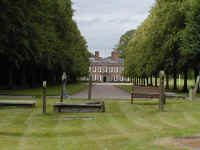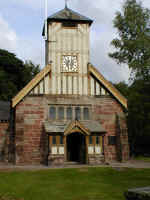| The central area of the parish is Whitmore, through which
passes the A53, which was an improved access to Whitmore Railway
Station. The original coach road passed through Butterton, Acton and
Whitmore. The coach line passing to the side of the Mainwaring Arms
to a row of cottages dated 1877 and on to a small stone building over the
Meece Brook: there is a beautiful bluebell wood beyond the bridge to the
right. On the original coach road is the former village school and
also the old Parsonage and Rectory. Whitmore Hall seen from the churchyard is surrounded by green
lawns and parkland and also a lake from which the Meece Brook flows.
The hall was a half timbered construction in 1676 with two gable end wings
adjoining a rectangular hall. In 1676, the hall was encased with
stone dressing in Flemish bond. There are four storeys and at the
front only two storeys and nine bay windows. The hall is open to
visitors at specified times. in 1676 with two gable end wings
adjoining a rectangular hall. In 1676, the hall was encased with
stone dressing in Flemish bond. There are four storeys and at the
front only two storeys and nine bay windows. The hall is open to
visitors at specified times.
Whitmore Church depicts the coat of arms on the west window of
the families who held Whitmore since the Norman Conquest; de Whitmore, de
Verdon, de Boughey, Mainwaring and Cavenagh, with the hall being passed
from generation to generation and changing when there was only an heiress.

The Church of St Mary and All
Saints may have stood from Saxon times, but the earliest structure
visible is from the Norman period. It became a Rectory in its own
right in 1807 and remains the benefice of Whitmore. The interior was
restored in 1880. Several memorials exist of the Mainwaring family
and an extensive and interesting booklet is available in the Church for
£1.50.
Whitmore Heath
Formerly Whitmore Common,
is in an elevated position overlooking the river Lea Valley which runs to
Madeley. Formerly covered in mixed brackens, heather, common birch
and oak. Developed in the 1950's with residential plots of up to
almost two acres and protected by Tree Preservation Orders. |